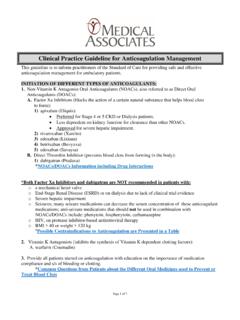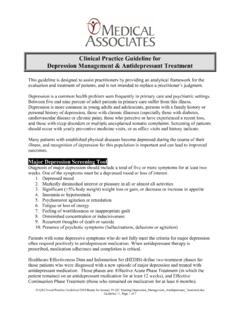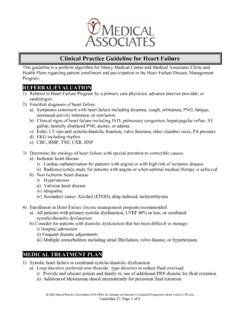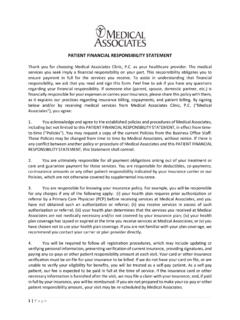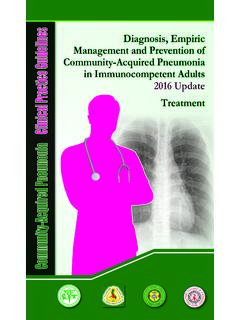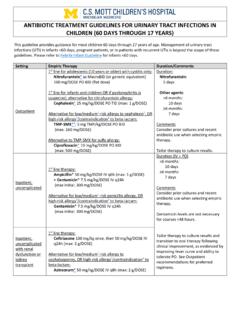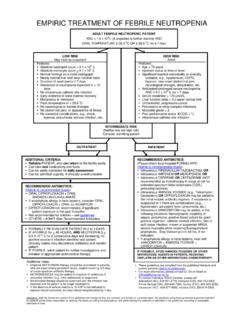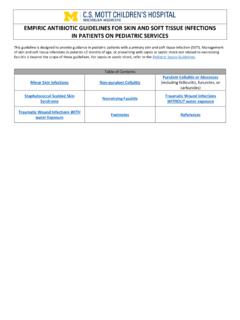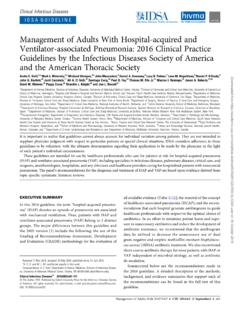Transcription of Clinical Practice Guideline for Sepsis Treatment ...
1 H:\QI\ Clinical Practice guidelines \2020\Completed\Final Word Documents\ Sepsis Page 1of 7 Clinical Practice Guideline for Sepsis Treatment - Hospital and Clinic Settings Sepsis is a serious, life-threatening rapidly progressive infection. The death rate can exceed 50% without rapid implementation of Treatment protocols. The patient s outcome depends on the etiology of the infection and the swiftness with which medical interventions commence. The guidelines set forth in this document outline the Treatment protocol for patients in both the clinic and hospital setting. These guidelines are based upon the Surviving Sepsis Campaign guidelines implemented as part of the Sepsis Initiative at Mercy One Hospital, Dubuque IA. The initiative incorporates elements of disease definition, intervention protocol, data collection, auditing all cases presenting with severe Sepsis and Septic Shock, feedback, and education. Table 1: Defining Sepsis as a Disease Continuum Infection/SIRS* Sepsis Severe Sepsis Adult Criteria A Clinical response arising SIRS Sepsis with 1 sign from a non-specific insult, with a of organ dysfunction, including two of the presumed or hypo-perfusion, or following: confirmed hypotension.
2 Infectious Examples: Temperature: > 38 C or < 36 C Process Cardiovascular, Heart Rate: > 90 beats/min Renal, Respiratory Respiration: > 20/min Hepatic, CNS, WBC count: > 12,000/mm3, Hematologic, or < 4,000/mm3 unexplained Metabolic or > 10% immature neutrophils Acidosis *SIRS = Systemic Inflammatory Response Syndrome Bone et al. Chest: 1992; 101:1644-1654 Figure 1 Workflow of Admission of septic patient from clinic H:\QI\ Clinical Practice guidelines \2020\Completed\Final Word Documents\ Sepsis Page 2 of 7 Sepsis Intervention for Clinic Setting: 1) Activate EMS (911). 2) Evaluate patient, address any immediate or life threatening issues. 3) Activate EMS again if necessary, especially for transport from West Campus to hospital. 4) Notify Mercy One Hospital house supervisor at #563-589-8300 to arrange for the encounter and a bed. (AKA Mercy Connect) 5) Re-evaluate patient, perform History and Physical.
3 6) Transport patient as soon as possible. 7) Enter orders (preferably in Cerner Powerchart), using Sepsis Bundle. 8) Notify hospital rounder of admission if the patient was admitted by their PCP in the clinic, and share pertinent Clinical information. Notify the hospitalist admitter if rapid transport is required. Sepsis Intervention for Hospital Setting : Goals WITHIN 3 HOURS of Presentation: 1) Measure lactate level (order follow up, if lactic acid is elevated). 2) Obtain blood culture (aerobic and anaerobic) prior to administration of antibiotics. Septic Patient in the Office911, transport to ERNoStableCall Hospitalist AdmitterYesDirect AdmissionAdmissionLaboratoryImagingMedic ationsObtain Bed& EncounterCBC&DiffChest X rayBroad Spectrum AntibioticsEnter Admission Order& Sepsis BundleCMPposs. CT Abdomen/Pelvisper Sepsis AdvisorCall Hospitalist RounderLactic AcidArea of InterestNotify ConsultantsUAPatient MedicationsBlood&Urine CultureCall Hospitalist RounderRounder follows patient after handoverAnd procalcitonin H:\QI\ Clinical Practice guidelines \2020\Completed\Final Word Documents\ Sepsis Page 3 of 7 3) Administer broad-spectrum antibiotics: a.
4 Recommended as soon as possible after recognition and within 1 hour: b. empiric broad-spectrum therapy with 1 or more antimicrobials to cover all likely pathogens (including bacterial, potentially fungal or viral) is recommended. c. Narrowing antimicrobial therapy is recommended once pathogen is identified and sensitivities are established and/or adequate Clinical improvement is noted. d. empiric combination therapy is suggested (using at least 2 antibiotics of different antimicrobial classes) aimed at the most likely bacterial pathogen(s) for the initial management of Septic Shock. e. If combination therapy is used for septic shock, de-escalation is recommended with discontinuation of combination therapy within the first few days in response to Clinical improvement and/or evidence of infection resolution. This applies to both targeted (for culture-positive infections) and empiric (for culture-negative infections) combination therapy. f. Antimicrobial Treatment duration of 7-10 days is suggested and adequate for most serious infections associated with Sepsis and Septic Shock.
5 G. Longer courses are appropriate and suggested in patients who have a slow Clinical response, undrainable foci of infection, bacteremia with Staphylococcus aureus, some fungal and viral infections, or immunologic deficiencies, including Neutropenia. h. Shorter courses are appropriate and suggested in some patients, particularly those with rapid Clinical resolution following effective source control of Intra-abdominal or Urinary Sepsis and those with anatomically uncomplicated Pyelonephritis. i. Daily assessment of de-escalation is recommended of antimicrobial therapy. j. Measurement of Procalcitonin levels is suggested to be used to support shortening the duration of antimicrobial therapy. k. Procalcitonin levels is suggested to be used to support the discontinuation of empiric antibiotics in patients initially appeared to have Sepsis , but subsequently have limited Clinical evidence of infection. NOT RECOMMENDED: Sustained systemic antimicrobial prophylaxis in patients with severe inflammatory states of noninfectious origin ( severe Pancreatitis, Burn injury).
6 Combination therapy used for ongoing Treatment of most other serious infections, including Bacteremia and Sepsis without Shock. (This does not preclude the use of multidrug therapy to broaden antimicrobial activity.) Combination therapy for the routine Treatment of Neutropenic Sepsis /Bacteremia. (This does not preclude the use of multidrug therapy to broaden antimicrobial activity.) 4) Administer bolus: 30 ml/kg Crystalloid for hypotension or a Lactate of > 4 mmol/L: a. Crystalloids are recommended and is the fluid of choice for initial resuscitation and subsequent intravascular volume replacement. b. Balanced Crystalloids or Saline for fluid resuscitation is suggested. c. Albumin in addition to Crystalloids for initial resuscitation and subsequent intravascular volume replacement is suggested when patients require substantial amounts of Crystalloids. d. Crystalloids over gelatins is suggested when resuscitating pts.
7 H:\QI\ Clinical Practice guidelines \2020\Completed\Final Word Documents\ Sepsis Page 4 of 7 NOT RECOMMENDED: Hydroxyethyl Starches for intravascular volume replacement. WITHIN 6 HOURS of Presentation: 5) Determine source of infection by imaging and laboratory ( , chest x-ray, CT abdomen/pelvis, urinalysis, blood culture (aerobic and anaerobic), etc). 6) Apply vasopressors (for hypotension that does not respond to fluid bolus) to maintain a mean arterial pressure (MAP) of 65 mm/Hg or greater. Norepinephrine is recommended and is first choice. a. Adding Vasopressin (up to ) or Epinephrine to Norepinephrine with the intent of raising MAP to target is suggested, or adding Vasopressin (up to ) to decrease Norepinephrine dosage. b. Using Dopamine as an alternative vasopressor agent to Norepinephrine is suggested only in highly selected patients ( pts with low risk of Tachyarrhythmias and absolute or relative Bradycardia). c. Using Dobutamine is suggested in pts who show evidence of persistent Hypoperfusion despite adequate fld loading and the use of vasopressor agents.
8 (If initiated, dosing should be titrated to an end point reflecting perfusion, and the agent reduced or discontinued in the face of worsening Hypotension or Arrhythmias.) d. Patients requiring vasopressors is suggested to have an arterial catheter placed as soon as practical if resources are available. NOT RECOMMENDED: Use of low dose Dopamine for renal protection. Use of Sodium Bicarb therapy to improve hemodynamics or to reduce vasopressor requirements in patients with hypoperfusion-induced Lactic Academia with pH 7) Obtain central venous access (IJ catheter, subclavian catheter, or PICC line) in the event of persistent arterial Hypotension despite volume resuscitation (Septic Shock) or initial Lactate greater than 4 mmol/L. Measure Central Venous Pressure (CVP) Measure Central Venous Oxygen saturation (ScVo2)-(more accurate than the CVP) Prompt removal of intravascular access devices is recommended that are a possible source of Sepsis or Septic Shock after other vascular access has been established.
9 ONGOING MANAGEMENT: 8) If fluid resuscitation and vasopressors do not restore hemodynamic stability, use IV Hydrocortisone 200 mg/day. H:\QI\ Clinical Practice guidelines \2020\Completed\Final Word Documents\ Sepsis Page 5 of 7 9) Intubation/Ventilation recommended goals for tidal volume in adult patients with Sepsis -Induced Acute Respiratory Distress Syndrome (ARDS): a. Using 6 ml/kg predicted body weight compared with 12ml/kg. b. Using an upper limit goal for plateau pressures of 30cm H20 over higher plateau pressures. c. Using higher Positive End-Expiratory Pressure (PEEP) is suggested over lower PEEP. d. Using recruitment maneuvers. e. Using prone over supine position and a Pao2/Fio2 ratio < 150mm Hg. f. Using neuromuscular blocking agents is suggested for 48 hours and a Pao2/Fio2 ratio < 150mm Hg. g. Conservative fld strategy on pts who don t have evidence of tissue perfusion. h. Using lower tidal volumes over higher tidal volumes is suggested in adult pts with Sepsis -Induced Respiratory Failure without ARDS.
10 I. Mechanically ventilated Sepsis pts be maintained with the head of bed elevated between 30-45 degrees to limit aspiration risk and to prevent development of ventilator-associated pneumonia. j. Using spontaneous breathing trials in mechanically ventilated pts with Sepsis who are ready for weaning. k. Using a weaning protocol in mechanically ventilated pts who can tolerate weaning. l. Continuous or intermittent sedation be minimized in mechanically ventilated Sepsis pts, targeting specific titration endpoints. NOT RECOMMENDED: High-frequency oscillatory ventilation. Use of -2 agonists for the Treatment of pts without bronchospasm. Routine use of the pulmonary artery catheter. 10) Target for glucose control is recommended with a protocolized approach: a. Commencing insulin dosing when 2 consecutive blood glucose levels are > 180mg/dl. This approach should target an upper blood glucose level 180mg/dl rather than an upper target blood glucose level 110mg/dl.

